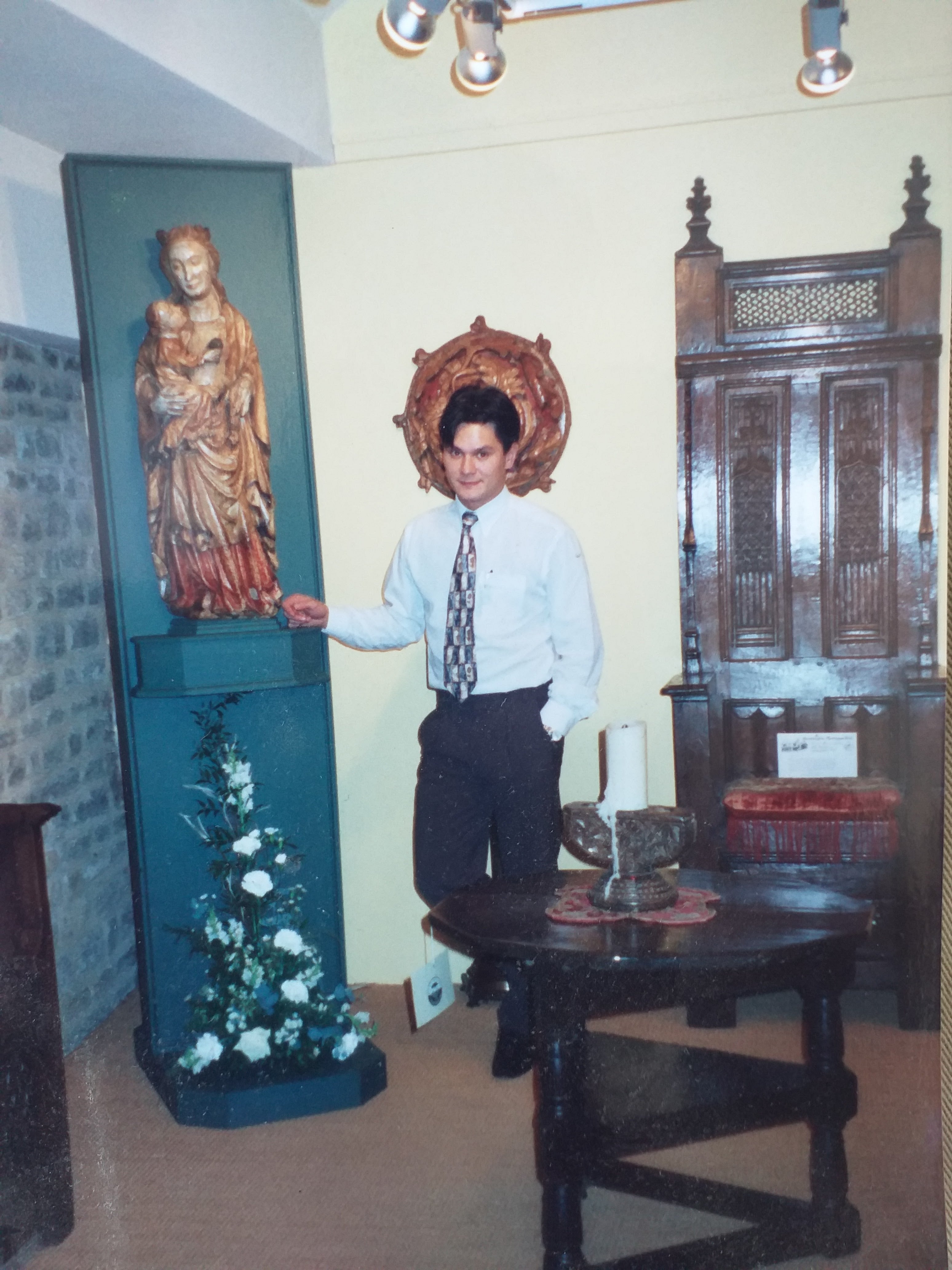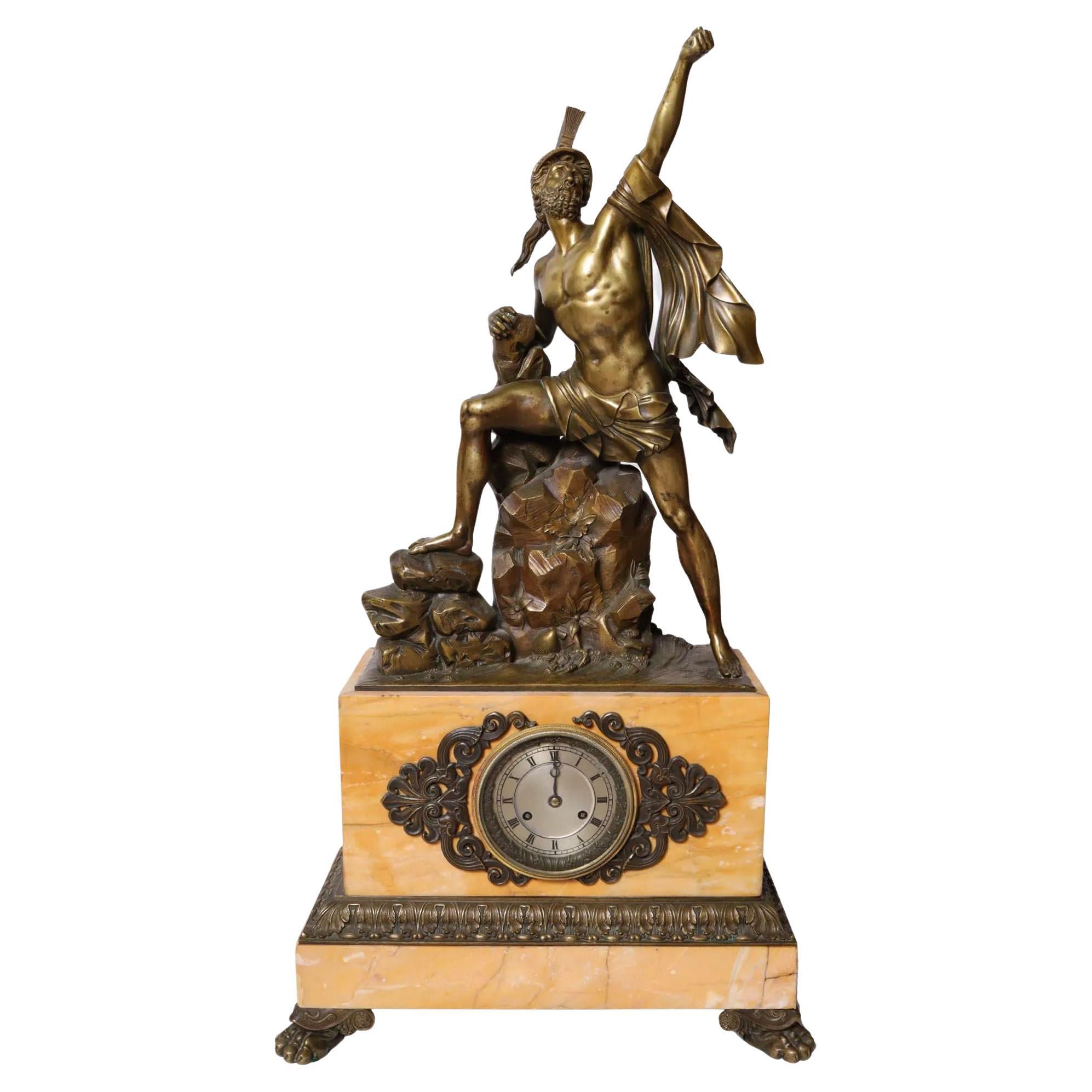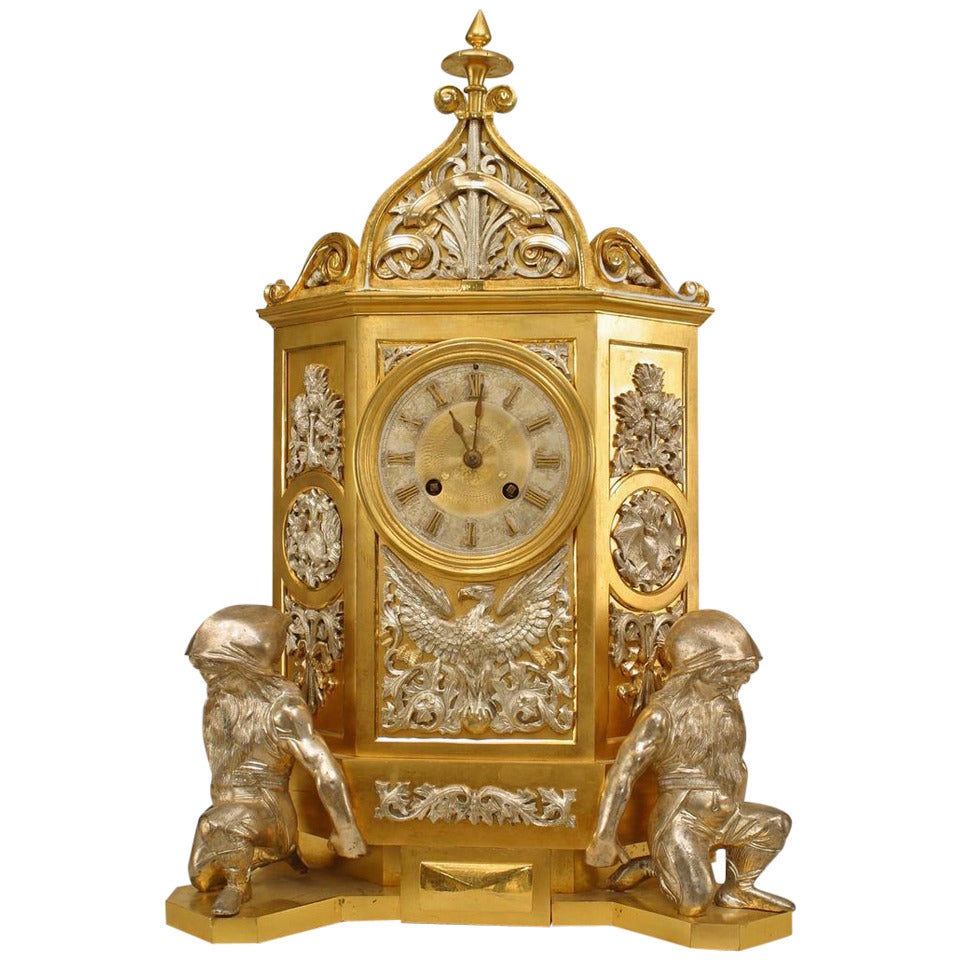Items Similar to Exquisite 19th Gothic Revival Mantle Clock of Young Girl Holding Spire by Pons
Want more images or videos?
Request additional images or videos from the seller
1 of 8
Exquisite 19th Gothic Revival Mantle Clock of Young Girl Holding Spire by Pons
About the Item
Exquisite gothic revival ormolu mantle clock depicting a young girl holding a gothic spire by Pierre-César Honoré Pons 1827
This clock has the extremely rare feature of retaining the original handblown glass case on ebony veneered base.
This method of atmospheric protection was reserved for only the finest and most precise clocks and instruments.
The clock has its original porcelain dial with hand painted blue Roman numerals and original hands. Thanks to the glass case the fired gilding is still as new and the movement shows no signs of any corrosion.
Made in Paris in 1827, this clock is made of ormolu and other metals. Ormolu is a gold-colored alloy of copper, zinc, and sometimes tin which is cast into desired shapes and often gilded
Stamped on the piece is Pons Medaille D’Or Paris 1827.
they used the 1827 Paris Medaille d'Or stamp which can be found on the present movement between 1827 and 1834, in 1834 they won the gold medal again for a second time.
Pierre-César Honoré Pons (1773-1851)), was a Parisian clockmaker who set up shop in 1803 and is generally recognized as being most active between the years of 1807-1846. Pons timepieces were manufactured in the French town of Saint-Nicolas d’Aliermont, and then sent to Paris for completion. Pons could manufacture beautiful, accurate timepieces at a fraction of the cost of other makers, due to his precision and self-invented machinery. Pons is credited with revitalizing the French clockmaking industry after the Revolution.
Honore Pons was one of the most renowned French clockmakers of his time; he worked in Saint Nicolas d'Aliermont from 1807 on. In 1819 Viscount Hericart de Thury wrote that a great number of eminent clockmakers "such as the Breguets, the Berthouds, the Janviers, the Robins, the Lepautes, the Bourdiers and the Pons…" were "known in the sciences of astronomy and physics…". Pons was an exceptionally resourceful maker of watches and clocks who designed and built the machinery for making his clocks himself. He invented his own type of movements and sold them to other watchmakers like Brocot; these movements are today known as Pons calibers. Pons frequently exhibited at fairs and was awarded numerous prizes and medals. When he died, he left a bequest of 1,000 francs to help watchmakers in need.
"Les Ouvriers du Temps", Jean-Dominique Augarde, Editions Antiquorum, Geneva, 1996. "Dictionnaire des Horlogers Français", Tardy, Paris, 1972.
Pierre-Honoré-César PONS (Paris, 1773 – 1851)
In 1789, Honoré Pons entered the workshop of Antide Janvier, who, in 1798, recommended him to the prestigious firm of Lepaute where he was hired as a clockmaker. On 9 January 1804, the young horologist presented his Observations sur l’échappement libre (Observations on a detached escapement) to the French Academy of Sciences, which earned him laudatory reviews and a commendation from the Academy. At thirty, Pons set up shop as a clockmaker on rue de la Huchette in Paris. In 1807, he was assigned by the State to revive the clockmaking industry of Saint-Nicolas-d'Aliermont, an important horology centre, near Dieppe, that comprised no fewer than 27 workshops. Known for his outstanding quality, Pons’ work had considerable influence on numerous renowned clockmakers. By the end of 1808 Pon’s success was already noted by academy scholars in their traditional report to Emperor Napoleon I on the progress of the sciences in France: ‘A few young individuals stand out, demonstrating notable talent and who […] one day will take the place of today’s great masters. The first of these, M. Pons, is not far from their ranks. His escapements are excellent; he has a passion for his art; he is an inventive thinker; his pinion and wheel cutting machine is an ingenious idea.’
Pons introduced machinery and production line methods for his Paris-style movements, which allowed for the considerable increase in production – up to 5000 movements per year – needed to supply the new industrial bourgeoisie’s strong demand for mantel clocks. In this manner he succeeded in developing the industry, while his participation at the Paris exhibitions earned him numerous awards for his perfectly crafted movements and remarkable precision timepieces; he received a Silver Medal in 1819 and 1823, and a Gold Medal in 1827, 1834, 1839 and 1844. After his death, the firm continued under the direction of Borromée Delépine in partnership with Cauchy, then, after the death of Delépine in October 1860, his son took over in a partnership with Barrois. The Delépine family received nothing less than a gold medal at the 1900 World’s Fair in Paris. The firm that was founded one hundred years earlier by Pons, had grown to 300 employees. As a true pioneer of the industrialisation of French clockmaking, Pons’ impact was considerable. All clockmakers of great renown were influenced by the quality of his work, in one-way or another.
Bibliography
Bibliography: Laurent de Commines, Eric Gizard, Un âge d'or des Arts décoratifs 1814-1848, Grand Palais, RMN 1991; Chavigny Richard, ‘Pierre-Honoré-César Pons, pionnier de l'horlogerie industrielle’, Bulletin de l'ANCAHA, no. 80, 1997; Pierre Kjellberg, Encyclopédie de la pendule française du Moyen Age au XXe siècle, Ed. L’amateur, 2005.
- Creator:Honoré Pons (Clockmaker)
- Dimensions:Height: 15.75 in (40 cm)Width: 9.85 in (25 cm)Depth: 5.91 in (15 cm)
- Style:Gothic Revival (Of the Period)
- Materials and Techniques:
- Place of Origin:
- Period:
- Date of Manufacture:1827
- Condition:
- Seller Location:Palma de mallorca, ES
- Reference Number:1stDibs: LU6722229072572

About the Seller
No Reviews Yet
Vetted Seller
These experienced sellers undergo a comprehensive evaluation by our team of in-house experts.
Established in 2001
1stDibs seller since 2022
- ShippingRetrieving quote...Ships From: Palma de mallorca, Spain
- Return PolicyThis item cannot be returned.
More From This SellerView All
- Late 19th century Terracotta Throne Chair from the Mannifatura di Signa workshopBy Manifattura di SignaLocated in Palma de mallorca, IBSTUNNING AND RARE LATE 19TH CENTURY TARRACOTTA THRONE CHAIR IN THE GREEK STYLE BY MANNUFATURE DI SIGNA FROM THE MANNIFATURA DI SIGNA WORKSHOP MADE IDENTICAL TO THE ANCIENT THRONE OF ST. GREGORY (church of san gregorio, italy) WHICH USED TO STAND AND WAS RECOVERED FROM THE IMPERIAL AREA WITHIN THE COLLOSEUM IN ROME AND COULD WELL HAVE BEEN THE CEASARS SEATING DURING THE SPECTACLES. Spectacular Greek Style Throne Chair with imposing fabulous beasts with rams heads armrests and a rounded back decorated with a mythical greek siren...Category
Antique Late 19th Century Belgian Greek Revival Chairs
MaterialsTerracotta
- Impressive 19th C. Carved and Black Lacquered Sidetable with Red Dragon RoundelLocated in Palma de mallorca, IBStupendous Qing Guangxu black lacquer side table with a red dragon roundel, With intricately carved apron all around standing on stylised feet. In excelle...Category
Antique Late 19th Century Chinese Qing Furniture
MaterialsWood, Lacquer
- Impressive Pair of Carved Giltwood 18th C. Armorial Lions Rampant Bearing ShieldLocated in Palma de mallorca, IBHighly decorative and well executed pair of gilt wood armorial shield bearing lions rampant sculptures. Holland or Flanders 18th century. Some retouchi...Category
Antique Late 18th Century Dutch Baroque Animal Sculptures
MaterialsGiltwood, Wood
- One of a Kind Spectacular Carved Spanish Colonial Style Bed of Grand ProportionsLocated in Palma de mallorca, IBUnique one of a kind Handcarved Spanish Colonial Style Bed of truly Grand Proportions. Carved in Solid Oak with multiple turned baluster supports an...Category
Early 20th Century Spanish Spanish Colonial Beds and Bed Frames
MaterialsOak
- Impressive and Finely Carved 17th Century Flemish Baroque Oak BuffetLocated in Palma de mallorca, IBOutstanding 17th Century Flemish Oak Buffet of Impressive proportions. With fine, deeply carved drawers displaying putti and floral decoration above a two door cupboard with geometri...Category
Antique 17th Century Belgian Baroque Buffets
MaterialsOak
- Stunning Early 20th Century Chinese Cinnabar Lacquered Royal Childs ThronechairLocated in Palma de mallorca, IBAbsolutely charming and rare 19th century cinnabar lacquered royal child throne chair. With bronze lion Couchant armrests indicating royal descent of occupying person. Retainin...Category
Antique Early 19th Century Chinese Chinoiserie Antiquities
MaterialsBronze
You May Also Like
- 19th Century Malachite and Gilt Bronze Mantel Clock by Honoré PonsBy Honoré PonsLocated in London, GBThis mantel clock is a truly beautiful piece of design, crafted by the leading early 19th century French clock-maker, Pierre-César Honoré Pons. Honoré Pons...Category
Antique Early 19th Century French Neoclassical Mantel Clocks
MaterialsMalachite, Bronze, Ormolu
- Early 1900s Gothic Revival Gilt Table Clock w. Christ Holding Lamb SculptureLocated in Lisse, NLStylish and meaningful Gothic mantel clock. This elaborate clock and religious work of art into one dates back to the earliest years of the twentieth century. Standing on the richly...Category
Early 20th Century French Gothic Revival Mantel Clocks
MaterialsAlabaster, Brass, Enamel, Spelter
- Greek Neoclassical Bronze Mantel Clock by Honore PonsBy Honoré PonsLocated in New York, NYOur Greek Revival period mantel clock in bronze with Siena marble case comes from the celebrated French horologist, Pierre-César Honoré Pons (1807-1846), c...Category
Antique Mid-19th Century French Greek Revival Mantel Clocks
MaterialsMarble, Bronze
- Gothic Revival Gilt Mantel ClockLocated in New York, NYEnglish Gothic Revival style (19th Cent) gilt mantle clock with silver plate decoration and supported by 2 gnome figures with a pediment having a fi...Category
Antique 19th Century English Gothic Revival Table Clocks and Desk Clocks
MaterialsMetal
- Unique Gothic Revival Gilt Bronze Mantle or Desk Clock w Rare Porcelain PlaquesBy W.H. TookeLocated in Lisse, NLWonderful clock for the collectors of truly stylish Gothic antiques, by W.H.Tooke, Paris. Finding this unique (Germany made) Gothic table clock again felt like a blessing. The overall design is remarkable, but the combination of the craftsmanship of the bronze components and the hand crafted and hand painted Gothic porcelain plaques is what takes this clock to the next level. Whenever you find a piece that is this good then you can rest assure that there is a maker's mark. This late 1800s work of beauty was made and marked by the prolific Parisian clock...Category
Antique Late 19th Century German Gothic Revival Table Clocks and Desk Cl...
MaterialsBronze
- Antique Gothic Revival Porcelain Clock by Dagoty & HonoréBy DagotyLocated in London, GBAntique Gothic Revival porcelain clock by Dagoty & Honoré French, c. 1830 Measures: Height 51cm, width 25.5cm, depth 17cm This beautiful Gothic Revival style porcelain clock was made by the prestigious French firm Dagoty and Honoré, founded by the esteemed porcelain makers Pierre-Louis Dagoty and Edouard Honoré...Category
Antique Early 19th Century French Gothic Revival Mantel Clocks
MaterialsPorcelain
Recently Viewed
View AllMore Ways To Browse
Watchmakers Shop
Young Manufacture
New Gothic
Machine 19th
Young Furniture Manufacturing
A L Holding
French Ebony
Used Master Clocks
Decorative Antique Fair
Girl Holding
Holding Up Hand
Young Talent
Gothic Metal
Antique Watch Clock
Antique Mantle Clocks
Antique Mantle Clock
Mantle Clocks Antique
Mantle Clock Antique





